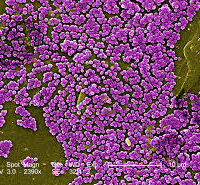Occasionally staphylococcus aureus populations grow to develop a resistance to novobiocin, tetracycline, and to a combination of these antibiotics. This can be highly problematic for researchers and healthcare providers alike. Due to its resistance to traditional antibiotic treatment, tetracycline, novobiocin, streptomycin resistant staphylococcus aureus is extremely contagious and is considered dangerous.
Transmission:
Antibiotic-resistant staph bacteria is commonly acquired via direct contact with an infected surface in a healthcare setting. Patients experiencing long-term acute care hospitals, which provide complex medical care, such as ventilator or wound care, for long periods of time are at higher risk. When an antibiotic-resistant staph skin infection occurs, cleaning and disinfection should be performed on surfaces that are likely to contact uncovered or poorly covered infections.
Symptoms:
Antibiotic-resistant staphylococcus aureus infection is considered especially dangerous due to its resistant to standard treatment. Once an infection takes place, patients can experience a variety of dangerous progressions. These include:
- Bacteremia or sepsis if bacteria spread to the bloodstream
- Pneumonia
- Heart failure or stroke
- Osteomyelitis



